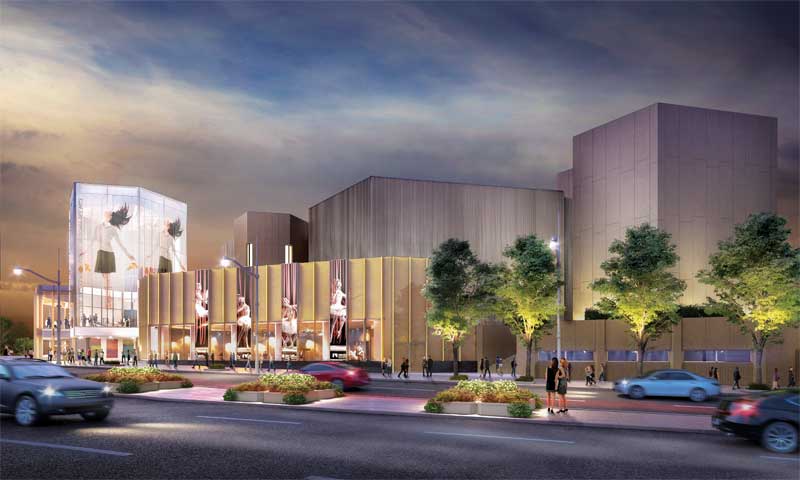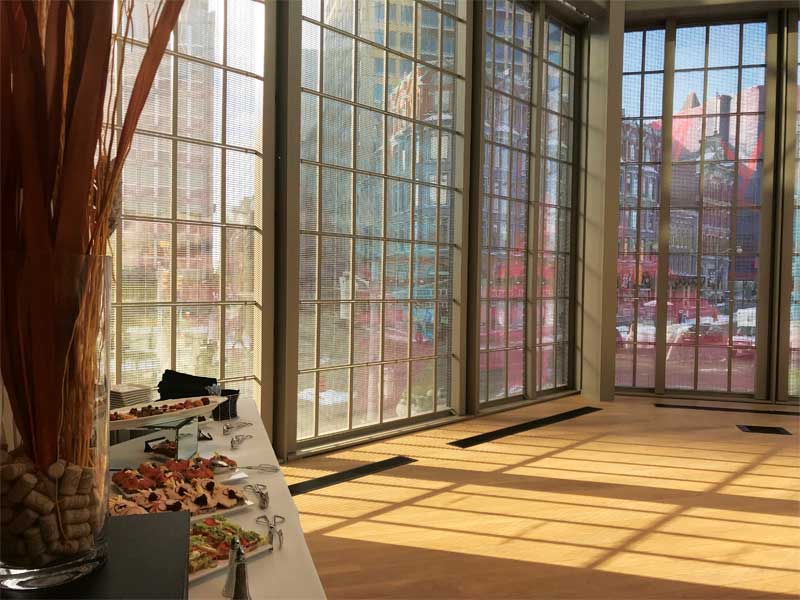
With the addition of the Kipnes Lantern, Diamond Schmitt Architects envisioned making the NAC more open to downtown Ottawa.
Rendering courtesy Diamond Schmitt Architects
Prototypes were developed before settling on the final system.
“We were brought on board in 2016, when the architectural designs were done and the steel structure was already in place,” says Fan. “The architects had seen our products in 2014, but there was a lot of customization needed for this project. They did not want exposed screwheads, for example, so we used countersunk screws with powdercoated covers that were the same colour as the building.”
Mounted on L-shaped aluminum brackets attached to the structure’s steel beams, the LEDs were angled slightly downward, to face pedestrians below the 400-m2 (4,306-sf) display. The PCBs were painted black on the display side to increase contrast levels and white on the back to minimize their visibility from inside the tower. The chassis to house the associated electronic components was designed in alignment with the steel architecture. In these ways, the integration of the display was made as visually seamless as possible.
In addition to providing the transparent digital screen, which spans four sides of the Lantern, ClearLED also built four smaller, solid, vertical ‘fin’ or ‘blade’ LED screens to
be installed along the building’s Elgin Street façade. All of the displays use programmed ambient light sensors and are automatically dimmed in response.
So far, the Lantern is only illuminated after 4 p.m., when sunlight is already fading in wintertime, but it is also designed for full daylight visibility, with a maximum brightness of 8,000 nits.
“It might be used during the day for special occasions,” says Fan.
The installation of the displays was completed in time for the official inauguration of the NAC’s renewal on July 1, 2017, with the opening of improved performance spaces, new wings for audiences and presentations and the aforementioned reorientation of the building to open onto the city’s downtown core, after having its concrete back turned on Ottawa for nearly 50 years. At that point, however, there was not yet any customized content to be displayed.
“The whole project had a very aggressive building schedule so it could open for Canada Day, with Prince Charles in attendance,” says Mallard, “but it would take longer to get the messaging right.”
Getting the content right
The development of the content strategy had begun in 2016, shortly after ClearLED became involved. The NAC’s Herrndorf assigned Christopher Dearlove and Bridget Mooney as project leaders for animation, based on their own project management backgrounds in the arts community.
“Peter had a vision for using the Lantern as a platform for elevating and celebrating great performances from across the country,” says Dearlove. “It would also be like a digital ‘campfire’ where people would come together in a public space. Ottawa doesn’t have many places like that.”
One of their key challenges was determining which content would play out well on a transparent screen.
“There weren’t a lot of them in use for comparison’s sake,” says Mooney. “I had only seen some while on a personal trip in Dubai, U.A.E. So, we had a lot to learn about the technology.”
The NAC already had lots of content from its own performances, but it was apparent a media agency partner would be needed to get the most out of those assets. Another RFP was issued, through which Montreal-based Moment Factory—well-known for large-scale nighttime projection mapping projects—was brought on-board in early 2017.







thanks
One key decision was to install the LEDs inside the tower, rather than engineer an outdoor-durable display.